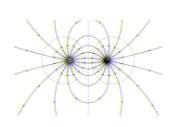Force Constant can be explained by Hooke’s law. This law is named after British physicist Robert Hooke, who lived in the 17th century.
Hooke’s law, in its most general form, allows you to determine the relationship between strain and stress for complicated objects based on the intrinsic qualities of the materials they’re composed of. When a uniformly cross-sectioned homogeneous rod is stretched, it behaves like a simple spring, with a stiffness k that is proportional to the cross-section area but inversely related to the length.
Spring constant:
Fspring = -kx
Where,
Fspring is the spring force
k is Force Constant
x is spring stretch or compression
Dimensional formula
In terms of dimensions, a dimensional formula is an equation that expresses the relationship between fundamental and derived units (equation). The letters L, M, and T are used to represent the three basic dimensions of length, mass, and time in mechanics.
All physical quantities can be stated in terms of the fundamental (base) units of length, mass, and time, multiplied by some factor (exponent).
The dimension of the amount in that base is the exponent of a base quantity that enters into the expression.
The units of fundamental quantities are expressed to determine the dimensions of physical quantities, as follows:
- ‘L’ stands for length,
- ‘M’ for mass, and
- ‘T’ for time.
Example: The area is equal to the product of two lengths. As a result, [A] = [L2]. That is, an area has two dimensions of length and zero dimensions of mass and time. In the same way, the volume is the product of three lengths. As a result, [V] = [L3]. That is, the volume dimension has three dimensions: length, mass, and time.
Dimensional equation
The physical quantity is equated with the dimensional formula, to get the dimensional equation.
Example: Velocity = [ M0 L1 T-1]
Here, velocity is the physical quantity, which is equated to the dimensional formula.
Dimensional Formula of Force Constant
Force Constant = Fx
Dimension of force = [M1 L1 T-2]
Dimension of displacement = [L]
Dimensional Formula of Force Constant = Fx = [M1 L1 T-2][L]
Dimensional Formula of Force Constant = [M1 L0 T-2]
2. Elastic Potential Energy
The energy stored in an object when compressed or stretched is known as elastic potential energy. For example- An archer pulls the bow with his hand.
Elastic potential energy is calculated from the formula, U= 12k x2
Where,
U = Elastic Potential Energy
k = Force Constant
x = The displacement in length on the string (in metre)
3. Electrical Potential Energy
The energy possessed by two charged bodies is known as electrical potential energy. For example, the energy possessed by the electrons present in the atom of an element.
U = q * V
Where,
U = electrical potential energy
Q = charge
V = electric potential in volts
Deducing an expression for the potential energy of a spring
In order to deduce the expression for the potential energy of a spring, we need to apply Hooke’s Law. The mathematical expression for Hooke’s Law is
F=-kx
Where ‘k’ is the constant and the ‘x’ is the displacement of the object.
Let’s assume the block is pulled by a distance of x in the opposite direction. Now we know that work done by the spring is given by:
W=0xF dx
= -∫kx.dx
= -k(x)22
The work done in pulling the object is given by W= kx22
Similarly, if you displace the object by a very small distance which is tending to zero, the work done by the spring is given by W=- kx22
Let the object be displaced from the initial position, say to the final position. Then the work done is then given by-
W=xfxikx. dx
=kxi22-kxf22
The expression clearly shows that the work done by the force acting on a spring depends on the displacement or the final or initial position of the object.
It is quite understood that the work done by the spring is dependent on the position of the object. In the case of cyclic motion, the work done by the spring is always zero as the work done to displace the object from the initial position ximoves back to its initial position.
Thus, work done by the spring in a cyclic process is given by:
W=xfxikx. dx=kxi22-kxf22=0
Conclusion
The dimensional formula of any physical quantity is an equation that explains how and which of the base quantities are contained in that amount. It is written by enclosing the symbols representing base amounts in square brackets with the corresponding power, i.e. ().
E.g., the Dimension formula of Displacement is: (L)
The dimensional formula depicts the dependency of physical quantity with fundamental physical quantity and the powers.
 Profile
Profile Settings
Settings Refer your friends
Refer your friends Sign out
Sign out







